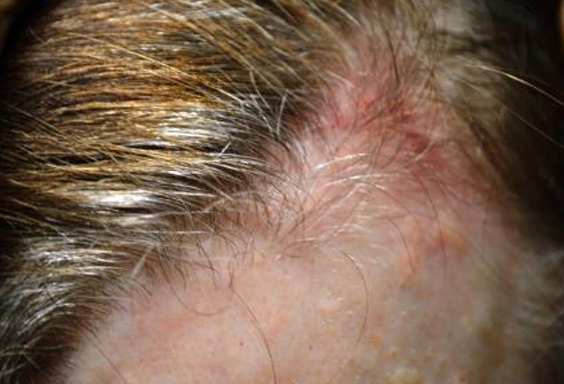What are shingles on scalp? Shingles is an infection caused by the same virus that causes chicken pox. That means one cannot develop shingles if they have not had a previous infection of chickenpox. The primary symptom of Shingles is a rash. It is however not uncommon for some people to develop the shingles with no rash. Both this forms of shingles are not contagious. Here are some of the symptoms, pictures and treatment option for shingles not only on scalp but also on other parts of the body.
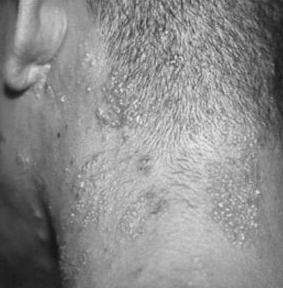
Shingles are also called herpes zoster. This infection is caused by the same virus that causes chicken pox. It is common in older people above 60 years. It occurs when the virus that caused chickenpox reactivates. Once infected with chicken pox, your body defense system becomes “immune” to the virus. After the chicken pox clears, the virus remains dormant in the root of the nerve cells.
The virus will then reactivate to cause shingles. The actual cause for the reactivation of the virus is not known. The risk of the virus reactivating, however, increases with increase in age, the weakening of the immune system, illness or some using some medicine. Other cause believed to cause the reactivation of the virus is said to be emotional stress.
Shingles on scalp symptoms
Just like on other parts of the body shingles on the scalp will often be accompanied by annoying symptoms such as itching and fluid filled bumps. According to Mayo Clinic, the signs and symptoms that accompany shingles will often affect only a small section of one side of your body.
Common signs and symptoms of shingles will include the following:
- Pain and burning sensation on scalp
- Numbness and tingling on face and scalp
- Red painful rash that often begins a few days after the rash
- Mild to severe itching
- Fever and abnormal body temperatures
- Severe headaches
- Somme people will experience sensitivity to light
- General fatigue
- Painful blood blisters on face
- Lesions, red, swollen patches on scalp
- Decreased appetite
Regardless of what the cause of the shingles on scalp is, pain is often the first symptoms most people complain of. For some people, the pain can be severe whereas in others the pain is mild depending on the location.
Wen left untreated for long, shingles on scalp can lead to complication, some of the complications caused by shingles can be life threatening.to prevent the risk of such complications, you need to contact your health care provider as soon as you notice any of the symptoms listed.
Mayo Clinic recommends you seek medical assistance if:
- The pain and rash start to occur near the eye. You risk having a permanent eye damage if the infection is left untreated.
- Older people should seek immediate medical attention, this is because the risk of a complication increases with age
- You have a weak or compromised immune system
- The rash, fluid-filled bumps or the painful blisters caused by the shingles are widespread, painful or distractive.
Shingles on scalp and ear pain
A rash is the most common symptom of shingle not only on scalp but when occurring in other parts of the body. In rare cases, those with shingles will often complain of an intense ear pain. This can be accompanied with an itchy rash around ear, mouth, face, and scalp or on neck.
Ear pain or hearing loss can be are common complication that often develops as a result of not treating the infection in time or correctly. To treat the ear pain:
- Use pain relievers such as non-steroidal anti-inflammatory medicine
- A simple warm compress can also help soothe and relieve the pain in ear
- For symptoms such itching and irritation inside ear, ear drops can be used
Shingles on scalp images, pictures
Here are some images of how shingles on scalp will look like.
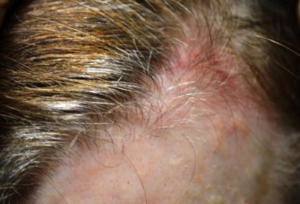
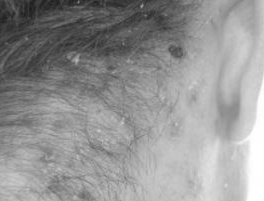
Shingles on scalp no rash
Is it possible to have shingles without rash? Yes, it is possible, it is however rare. With this kind of shingles on scalp, it can be very difficult to diagnose the shingles since the primary symptoms of the condition is the rash, which in this case is not present.
Just like the common form of shingles one with the rash), the virus that causes chicken pox is also responsible for the formation of this type of shingles (shingles without rash). The virus, in this case, is known as herpes zoster.
The difference between chicken pox and shingles is this: chicken pox is caused by a virus called varicella zoster, once infected by this virus, it remains dominant in your nerve cells. Until now, medical experts are yet to understand why the virus reactivate. Now, the virus reactivates to from shingles, in such case, the virus is known as herpes zoster.
Research, however, shows that shingles often occur in people with weak or compromised immune system. This would include people undergoing chemotherapy, radiation therapy, HIVAIDS, those taking high doses of corticosteroids, and people with high level of stress.
The symptoms of shingles on scalp with rash are the same to those of the shingle without the rash. The main difference is the lack of rash. The symptoms can be seen on scalp, in most case, the symptoms are often isolated on one side of the body. In most case, the symptoms can be seen on face, neck and around eyes.
Typical symptoms of shingle without a rash will include:
- A feeling of burning sensation
- Numbness and tingling
- General feeling of fatigue
- Pain radiating from the spine
- The scalp become sensitive to touch
Shingles on scalp with swollen lymph nodes
Swollen lymph nodes is a common symptom in people with shingles on scalp. Lymph nodes also called lymph glands are an important part of the immune system. These nodes are located throughout the body, they are however only visible and palpable when enlarged or swollen.
Lymph node will often swell in one location due to an infection, an injury or a growth of a tumor. Shingle on scalp is a viral infection. As said, lymph nodes are part of the immune system which helps fight infection in the body. These nodes work by carrying lymph fluid, nutrients and waste material between the body tissues and the bloodstream.
The location the nodes are swollen can help identify the problem.
- A swelling on side of neck, under the jaw or behind ear will in most cases swell when you have a cold or a sore throat. The virus causing shingles can also be a cause for the swelling.
- A swelling of the nodes in armpit is often caused by an injury or an infection in the arm or hand
- Lymph nodes above the collarbone, on the other hand, may be as a result of an infection or growth of a tumor in the areas around the lung, breasts, neck or the abdomen.
Shingles on scalp can lead to complication if improper treatment is not taken. According to the national health services united kingdom, complications of shingles are more likely if you have a weakened immune system, or older than 50-60 years of age.
Apart from the swelling of the lymph nodes, other complications of shingles will include the following:
Post herpetic neuralgia
According to the national health services NHS, this is the most common complication of shingles. It is not clear how many people are affected, it is however estimated that 1 in 5 people over 50 years could develop this complication as a result of shingles.
With this condition, one can experience severe pain, and intense itching that often persists after the rash and other symptoms of the rash have cleared. Some people will experience constant or intermittent burning, throbbing or shooting pain, others may experience allodynia (one feels pain from something that should not be painful). Other people will experience hyperalgesia, in this cases, those infected are very sensitive to pain.
Though post-herpetic neuralgia can last for years, in most people, the complication often resolves after around three to six months.
Eye complications
Eye problem is another complication associated with shingles especially when the eyes get infected. If urgent medical treatment is not considered, there is a risk you could develop further problems or complication in the affected eye.
Some of the complications would include:
- Soreness and permanent scarring
- Inflammation of the eye and optic nerve
- Glaucoma, in this cases, pressure builds up inside the affected eye
- Permanent vision loss when the condition is not treated properly.
Ramsay Hunt syndrome
Finally, if shingle is not treated properly or in time, it could lead to Ramsay Hunt syndrome. This is a complication that occurs if shingles affect certain nerves in your head. In the United States and the United Kingdom, the condition is estimated to affect 5 in every 100, 000 people.
This complication can result in earaches, dizziness, rash around the ear, weakness of the face, among other unwanted symptoms.
In cases of Ramsay Hunt syndrome, the complication is often treated with antiviral and corticosteroids. Early treatment increases the chances of full recovery, when delayed, only half of those treated will recover completely. Those who do not recover completely, are left with permanent problems such as a degree of permanent facial paralysis or hearing loss according to the national health services.
Are Shingle on scalp contagious?
Shingle on scalp or on other parts of the body is not contagious. What that means is that you cannot give it to someone else. However, the virus that causes chicken pox is highly contagious. The virus can be spread through physical contact with people who have not had chickenpox before or who were not vaccinated against the virus.
Remember, it is the virus that causes chicken that activates to cause shingles on scalp. Once infected with the varicella virus, your immune system releases antibodies that protect your body from future infections of the virus.
To reduce the risk of transmitting the virus from an infected person to those not infected, you need to reduce physical contact until the symptoms clear. Shingles without rash is however not contagious, It is however advised to reduce close physical contact with those not infected with the virus, especially pregnant women and those with weak or compromised immune system.
Treatment
Shingles on scalp as said is a skin condition caused by varicella zoster virus. This is the same virus that causes chicken pox. On scalp this condition causes painful inflamed rashes, the rash can occur on any part of the body.
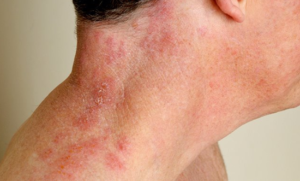
So what is the right treatment for shingles? Currently, there is no cure for shingles. However, according to WebMD, treatment n for this skin condition may shorten the illness and prevent complication from occurring.
When treating shingles on scalp, most healthcare provider may prescribe:
- An antiviral medicine which helps to reduce pain and duration of the shingles. Your healthcare provider is like to prescribe medicine such as acyclovir, famciclovir or Valacyclovir. When these medicines are used correctly, they work by reducing pain and duration of the shingles on scalp.
- Over the counter pain medication may also be used in some cases. This medicine may help reduce pain during shingles attack. When using an over the counter medication, you need to be very careful, make sure to read and follow all the instruction on the level.
- Finally, topical creams and ointmentcan also be used to relieve long-term pain. Topical antibiotic applied directly on the scalp may help reduce symptoms such as itching, inflammation, pain, and swelling.
- Topical creams may also be applied directly on the scalp to stop infection of the blisters and bumps that form on the skin.
- Corticosteroids along with antiviralmedicine can be prescribed in severe cases of shingles. Corticosteroids are however not often used.
Once you are diagnosed with the virus causing shingles, your health care provider will most probably prescribe antiviral medicine. With treatment, there are high chances of reducing the risk of complication.
Shingles on scalp can be extremely painful, as said, delaying or not getting medical treatment may increase the risk of complications. There are some simple natural remedies you can use at home to try and keep some of the symptoms of shingles in cheek.
Also, depending on what the underlying cause of the shingles is, the treatment will vary. Stress and fatigue are said to be the common cause of this condition. In such cases, you can use emotional healing technique to keep thing under control.
After using antiviral medication, you can also use the following home remedies to reduce the pain and discomfort caused by shingles on scalp.
1. Cold compress
A cool compress works by relieving the pain and itchiness associated with shingles rash. At home, all you have to do is take a cold shower or bath twice a day or in intervals of 4 hours. Alternatively, soak a face towel in cool water, then apply it to the rash and painful blisters caused by the rash.
2. Baking soda
The other simple way to relieve the symptom of shingles on scalp is by using baking soda. Baking soda is said to be a great anti-itching and antifungal remedy. To use this remedy:
- Add two tablespoon of baking soda in a cup
- To it, add one part water,
- Gently stir to mix until you achieve a fine paste
- Apply the mixture to your rash
- Do this twice or thrice in a day
3. Aloe Vera
Aloe Vera gel is the other great natural remedy you can use to relieve the symptoms of shingles. It has antibacterial and antiseptic properties that can help prevent further infection, it also has anti-itching and anti-inflammatory qualities that can help soothe and relieve itching and inflammation.
All you have to do is:
- Squeeze aloe Vera gel from a fresh aloe leave
- Clean your scalp then gently apply the oil
- Leave it on for some minutes
- Repeat this thrice a day for optimal results.
4. Dietary remedies
A compromised or weakened immune system may worsen shingles on scalp. The best way to strengthen and boost your immune system would be to make some dietary changes. This may also help prevent the shingles from spreading to other parts of the body.
Avoid foods that might compromise your immune system and stick to those that will help boost its functionality. Shingles diet will often consist of vitamin A, B-12, C, and E. make sure to also include amino acid lysine in your diet.
5. Tea tree oil
Naturally, tea tree oil is a great antiviral agent. This remedy can help heal shingles and its anesthetic properties might help reduce pain that is most often associated with shingles on scalp.
Tea tree oil also has antibacterial and antiseptic properties that might help prevent further infection. Simply apply few drop of the essential oil on scalp. For those with sensitive skin, make sure to dilute the oil before using it on your skin.
Other home treatment you might use to soothe and treat shingles on scalp would include the following:
- Peppermint
- Chamomile Oil
- Oregano oil
- Clove oil
For those who have not had chickenpox before, you can do the following to help prevent the infection which will, in turn, prevent against shingles on scalp and on other parts of the body. The following will help prevent shingles:
- Vaccinate against the chicken pox virus
- If you have had chicken pox before, a vaccine called Zostavax especially for older people above 60 years, is available to help prevent and lessen the symptoms of shingles. ( this is not a treatment for shingles)
- You can also protect or boost your immune system to reduce the chances of you getting shingles.
Sources and references
- http://www.nhs.uk/Conditions/Shingles/Pages/Complications.aspx
- http://www.webmd.com/skin-problems-and-treatments/shingles/tc/shingles-what-happens
- http://www.healthline.com/health/shingles-without-rash#overview1
- http://www.healthline.com/health-slideshow/early-symptoms-shingles
- http://www.medicinenet.com/swollen_lymph_nodes/article.htm
